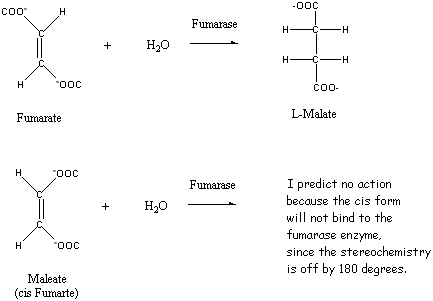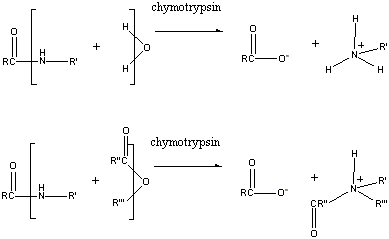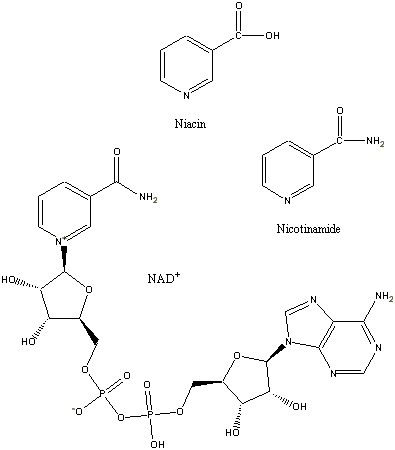
|
Dr. Raney
|
Biochemistry 5104
Problem Set 2 |
L. Van Warren
9/24/99 |
Problems Chapter 12, Problems 1 - 7
Chapter 12, Problem 1, states:
Q: Indicate the products of the YADH reaction with normal acetaldehyde and NADH in D2O solution:
A: The reaction below shows:

1) that there is a one to one correspondence between the D on
NADD and the D on the ethanol, and
2) the proton that appears on the hydroxyl group comes from solution.
Therefore if we run the reaction with normal acetaldehyde and NADH in D20 there must be no D appearing on the ethanol primary carbon, but there must be a D appearing on the hydroxyl group, to wit:

Chapter 12, Problem 2, states:
Q: Indicate the products of the YADH-catalysed oxidation of the chiral methanol derivative (R)-TDHCOH.
A: First we check if YADH can even catalyze the oxidation of methanol. It turns out that it can, but it is some 25 times slower. Next we draw the YADH reaction:

and by analogy we have the corresponding methanol oxidation:

Chapter 12, Problem 3, states:
Q: The enzyme fumarase catalyzes the hydration of
the double bond of fumarate.
Predict the action of fumarase on maleate, the
cis isomer of fumarate.

Chapter 12, Problem 4, states:
Q: Write a balanced equation for the chymotrypsin-catalyzed reaction between an ester and an amino acid.
A: We exploit the fact that chymotrypsin is much less specific than most enzymes, cleaving after the carbonyl in both the peptide and ester cases:

Chapter 12, Problem 5, states:
Q: Hominy grits, a regional delicacy of the Southern United States, is made from corn that has been soaked in a weak lye (NaOH) solution. What is the function of this unusual treatment.

A: Soaking the corn in sodium hydroxide increases the absorption of nicotinamide through the intestine. This has the effect of making the Niacin, or Vitamin B3 more bioavailable. This prevents the Vitamin B-3 deficiency known as pellagra. The amide form of nicontinic acid is a significant substructure in NAD+ and NADP+ which are implicated in the following biochemical pathways, [ref, http://www.expasy.ch/cgi-bin/search-biochem-index?NAD]
ALDEHYDE DEHYDROGENASE (NAD+) Available map(s): A2, D6, D8,
E6, H2, I2, J10
DIHYDROURACIL DEHYDROGENASE (NAD+) Available
map(s): J8
GLUTATHIONE REDUCTASE (NAD(P)H) Available map(s): H7,
I7
GLYCEROL-3-PHOSPHATE DEHYDROGENASE (NAD+) Available map(s):
D6
ISOCITRATE DEHYDROGENASE (NAD+) Available map(s): G6
NAD(P)+ TRANSHYDROGENASE Available map(s): J1, S10
NAD+ KINASE Available map(s): J1
NAD+ SYNTHASE Available map(s): J1
NICOTINAMIDE ADENINE DINUCLEOTIDE[NAD+] Available map(s):
J1
POLYDEOXYRIBONUCLEOTIDE SYNTHASE(NAD+) [DNA LIGASE] Available
map(s): O7, Q6, R6, S7
2-PROPANOL DEHYDROGENASE (NAD+)
RUBREDOXIN-NAD(+) REDUCTASE Available map(s): D8, D9
SACCHAROPINE DEHYDROGENASE (NAD+,L-GLUTAMATE-FORMING)
Available map(s): J3
SACCHAROPINE DEHYDROGENASE (NAD+,L-LYSINE-FORMING) Available
map(s): J3
SUCCINATE-SEMIALDEHYDE DEHYDROGENASE (NAD(P)+) Available
map(s): H5
Chapter 12, Problem 6, states:
Q: Which of the curves in Voet Fig 12-5 exhibits the greatest cooperativity? Explain.
A: ATP increases the enzyme's catalytic rate. In hemoglobin, subsequent O2 bindings increase the affinity of the tetramer for additional oxygens. This is termed positive cooperativity in the Hill constant sense. Therefore by analogy we might associate the notions of binding cooperativity and affinity with catalytic rate, provided the enzyme is willing to "let go" of the catalyzed product.
Chapter 12, Problem 7, states:
Q: What are the advantages of having the final product of a multistep metabolic pathway inhibit the enzyme that catalyzes the first step?
A: It down regulates the pathway and provides closed loop feedback to keep the pathway in equilibrium.